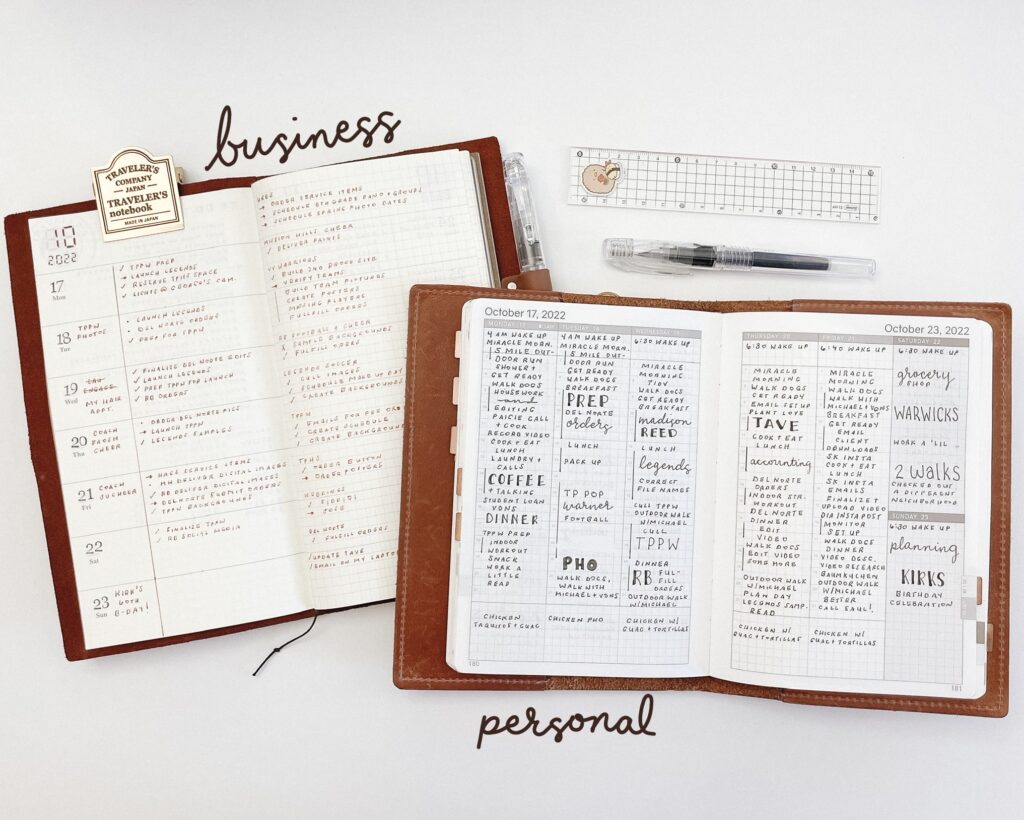Here are a few steps to help you choose a planner that works for you.
When it comes to planning, part of the fun is learning how to choose a planner that works for you and your lifestyle. These are just 7 things to consider when purchasing a planner. I can honestly go on all day about the options and best reasons to use specific planners. But I didn’t want this post to go on forever! So, if you have any questions or need some advice, PLEASE feel free to message me. I never tire of talking about planners and productivity.
How to Choose a Planner
1. What will you be using your planner for?
Why do you need a planner? Do you need to keep track of your work schedule, the kids’ soccer practices, and doctor appointments, or to track day-to-day tasks?
I currently use my main planner to track habits and goals, keep appointments, log my weekly schedule, create to-do lists, and do light-hearted journaling.
I also use a Wondeland222 for my Content Planning. What I require in each planner is different, so keep in mind that you can always use multiple planners!
Ask yourself:
- What do I need my planner to accomplish for me?
- Do I need a general overview of the month?
- Should I get a weekly layout so that I can time block?
- Will daily pages with an hourly breakdown and space to put my priority tasks be most beneficial?
- Do I want the freedom to pick up the planner and use it anytime, or do I want a predated planner to keep me consistent?
There are so many more questions you can ask yourself to find the right planner, but this is a good start!
2. Select your layouts and binding style
Once you have a better idea of what you need in a planner, you can decide on the layouts you need.
Will you need a monthly calendar if you keep all your appointments on your phone?
What type of weekly pages will serve you best, horizontal or vertical?
Do you want daily pages with sections for notes and ideas?
Then you need to decide what kind of binding you would like.
Is there a bound planner out there that has all the spreads your planner heart desires? My favorites are Hobonichi, Common Planner, and Wonderland222.
Do you prefer rings or discs? My very first planner was a Franklin Covey Ring Planner. I was raising young children at the time and really loved that I could change the design of my planning pages at any time. My planner was constantly able to keep up with my evolving needs. On the downside: Because the planner pages were loose-leaf, I had a tenancy to throw them away at the end of the week or month. I wish I still had them to look back and reflect on. It became easier to save my past-bound journals because they seemed more like books. Lesson – be sure to have a special place to keep these precious memories when they no longer fit in your planner!
There is also a type of hybrid planner. The Traveler’s notebook. While each planner book is bound, you can have several different inserts in one leather cover. I will leave all that for another blog post!
3. Select your planner size
Here are a few common planner sizes (may vary by manufacturer):
Letter – 8.5 x 11 in
A5 – 5.8 x 8.3 in
B6 – 5 x 7 in
A6 – 4.1 x 5.8 in
What is more important to you in a planner? Portability or space to write?
l have always been an A5 girl while dabbling in some smaller sizes, but I am not in a B6 Sterling Ink Common Planner, and I don’t see that changing anytime soon! I consider it to be my Goldilocks size.
4. Think about the design
What colors, patterns, and textures do you like? Do you prefer minimalistic designs or something more decorative?
There are an overwhelming number of choices out there. Stop by your local Target or hop on Amazon to see what options are easy to grab.
If you want to get fancy, check out the many planner accounts on Instagram. You will learn about new brands and how 5 different people use the same planner differently. Be careful; you may fall down the rabbit hole.
5. Research the different types of planners that are available
There are paper planners, digital planners, and hybrid planners. Consider which type would be the most suitable for your lifestyle.
Also, consider usability. How easy is it to use the planner? Is it user-friendly?
6. Decide on a budget
If you are new to planning, you may want to start with a less expensive planner. Maybe test a few and decide what type works best for you. Once planning has become a habit and valuable tool in your life, you may want to invest in something of better quality that will last.
I have a Hobonichi 5-year Journal that I spent a good chunk of change on, but it was money well invested. I use it every day, and I will be using it for 5 years. That’s 1,825 days!
Set a budget for your planner, consider how much you can realistically spend, and stick to it.
7. Test it out
Once you have narrowed it down to a few options, get a sample of each and test them out. Some planners, like the Passion Planner, come with free printables to test the pages and sizes before purchasing.
I was interested in a workout planner by The Clever Fox, so I drew it out myself in a notebook, bullet journal style, and tested it out for myself. It was a bit time-consuming, but I quickly realized that the layout was not for me.
Be sure to see which works best for you and your planning needs.





